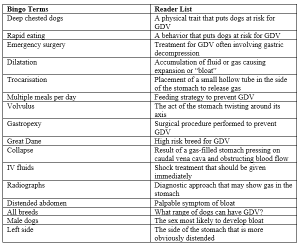134 Bloat Busters – Instructor Guide
Bloat Busters
Instructional Guide
Learners will work to understand what Gastric Dilatation Volvulus (GDV) is and its effects in dogs.
Intended Grade Level
This lesson is intended for students in grades 9th-12th. Students should be aware of general GI physiology and what the functions of the stomach are. Students should also feel comfortable with basic scientific terminology.
Learning objectives
- Define Gastric Dilation and Volvulus (GDV) in dogs.
- Understand the risk factors of GDV.
- Name ways to prevent bloat/GDV in dogs.
- Understand how to treat bloat/GDV.
Lesson Format
This can be done in any size group. The material can be printed and disseminated. Activities require a printer and pens.
- First students will read a background on gastric dilation and volvulus, as well as section on the mechanics of GDV (20 minutes)
- Students will learn about risk factors, diagnostics, bloat prevention, and bloat treatment (25 minutes)
- Then, students will play Bloat Buster Bingo. Details are further explained in the activities section. (10 minutes)
- The assessment will be a short quiz based on the learning objectives (5 minutes)
Lesson Background
Canines (dogs) have a gastrointestinal tract very similar to ours. Their esophagus leads to their simple stomach, which can expand to accommodate large meals because they are omnivorous predators and usually eat larger meals at a time, with breaks in between. This is followed by small intestines, large intestines, and a rectum leading to the anus. Food is digested by acid and enzymes in the stomach, as well as in the small intestine. They have tall, sharp teeth as needed for tearing and chewing on meat and bones. Dogs can experience a gastric torsion and volvulus (GDV). This is when the stomach twists upon itself and is usually caused by consuming a large amount of food or air. Deep-chested dogs are more at risk. This restricts blood flow to part of the digestive system and blocks ingesta (partially digested food) from moving through. With things not able to move through, the animal cannot absorb nutrients or water and can become dehydrated and malnourished. They can appear bloated/with a distended abdomen from gas accumulation, be drooling, not wanting to eat, and in pain. A tube is usually passed to try to relieve gas in the stomach, and surgery is often required. Some vets may perform a surgery to tack the stomach wall to the body wall to prevent this if the dog has had an occurrence or if it is a breed that is commonly predisposed to experiencing this. Here is a quick video to visualize a stomach twist:
Activities
Students will follow this link to generate a bingo card to play Bloat Buster Bingo. One reader will read from the terms list (seen below), and as each bingo player hears a description that matches a spot on their bingo board, they can mark it off. The first person to get 4 terms in a row wins. After the first person wins, the reader should continue until all terms are read out.

Common misconceptions and challenge points
-
Students may think bloating is just uncomfortable but not dangerous, and may not understand how quickly it can escalate into a life-threatening emergency in animals.
-
Students may have a difficult time understanding that gastric distension can be normal or mild, while GDV involves a twisted stomach and is a severe medical emergency.
-
Students may not be aware of other causes of GDV like rapid ingestion, pica (eating non-food items), or underlying health issues, and may only believe that it is due to eating too much.
Assessment
Students will take a short, 5 multiple-choice question quiz that reflects the content of the lesson, focusing on the student learning objectives.
Further exploration and resources
VCA Hospitals: Bloat: Gastric Dilation and Volvulus in Dogs
AKC: Bloat (or GDV) in Dogs: What Is it and How is it treated?
Today’s Veterinary Practice: Gastric Dilatation and Volvulus: Stabilization and Surgery
Other lessons within this textbook may be interesting for students. Links to these chapters can be found below:

